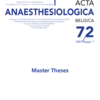Survival of elderly COVID-19 intensive care patients in the first and second Belgian wave: a retrospective single center analysis
COVID-19; SARS-CoV-2; critical care; elderly; aged
Published online: Apr 21 2022
Abstract
Coronavirus disease 2019 emerged in China at the end of 2019 and rapidly spread throughout the rest of the world. In 2020, Belgium experienced two waves of COVID-19 infections. In the first wave (March, April and May 2020), scientific knowledge was very limited and therapy consisted of supportive care and experimental drugs like hydroxychloroquine, ritonavir/lopinavir and remdesivir. Although curative therapy was still lacking, there was a large increase in knowledge on COVID-19 by the time the second wave occurred (October, November, December 2020). The previously mentioned experimental drugs were no longer administered, dexa- methasone became part of the standard therapy and prophylactic anticoagulation dosing was increased. The use of high flow nasal cannula was maximized and in case of mechanical ventilation, pressure-controlled ventilation was chosen.
In this analysis, characteristics and outcomes of elderly intensive care patients in one Belgian tertiary center during the first and second wave were compared, as a sub-analysis of the European COVIP trial (Corona Virus disease (COVID19) in Very Elderly Intensive care Patients (VIPs). A VIP network study). In the first and second wave, respectively 44 and 46 patients of 70 years and older with COVID-19 were admitted to the ICU in ZOL Genk. No significant differences were demonstrated in baseline characteristics between the first and second wave. Mean age (77 years in both waves) and disease severity (APACHE IV score 34 in the first wave and 33 in the second) were comparable. As for outcome, we found no difference in 90-day, 30-day and ICU survival. Twenty-three patients (52.27%) survived their first 90 days in the first wave, whereas 24 patients (52.17%) did so in the second wave. Median length of stay was not significantly different, 190 hours (7.92 days) in the first wave, 174 hours (7.25 days) in the second wave. The lack of improvement in survival during the second wave may be due to the already selective use of corticosteroids during the first wave, the only known drug to have some effect on patient outcome in COVID-19. The 90-day survival rate of elderly patients admitted to the ICU for COVID-19 was in line with the 52% of the European COVIP registry.
